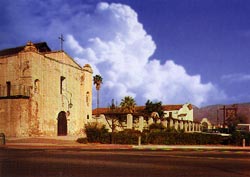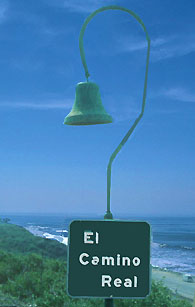|
|
EARLY SETTLERS OF LOS ANGELES
In 1769 a party of Spanish explorers were developing a trail between San Diego and San Francisco which became known as El Camino Real. A series of 21 missions would be established along this trail. Led by Father Junipero Serra and Captain Gaspar de Portola, and with Father Juan Crespi to record what they saw, the expedition of about 67 men entered what is now Los Angeles by way of Elysian Park on August 2, 1769. They persuaded settlers to come here from Mexico. A group of 11 men, 11 women and 22 children came together at the Mission San Gabriel. On September 4, 1781, they left San Gabriel, with soldiers, mission priests, and a few Indians to settle along the California coast. The new pueblo grew slowly. The houses were small, usually of adobe with flat roofs, glass-less windows, and rawhide doors. The narrow streets were almost impassable when it rained. By 1790, Los Angeles had 28 households and a population of 139. By 1800 there were 70 households and a population of 315. They also had a small town, guardhouse, and army barracks. This Spanish town neither knew nor cared that the United States had been born and was already moving relentlessly across the continent. The first Yankee settler did not arrive until about 1820.
|
 MISSION SAN GABRIEL
MISSION SAN GABRIEL
|
|
THE HISTORY OF THE BELLS
The history of the El Camino Real and its bells, is quite interesting. At the same time that the American colonies were rebelling against England, a handful of Spaniards and Mexicans established outposts along the California coast. The first was established in 1769 in San Diego, when they built a fortress and a Franciscan mission. From that point, a series of small self-reliant religious missions were establised. Each was a day's travel apart and linked by El Camino Real. Overall, El Camino Real ("The King's Highway") linked the 21 missions, pueblos and four presidios from San Diego to Sonoma. The bells in fact often served as highway signage, working as markers for California motorists. By 1949, there were around 286 bells along the road. That number had dwindled to 75 bells, due to theft and vandalism, but today anyone can "adopt a bell", and maintain them. There are now close to 380 bells left along the California coast.
|
|
THE DIARY OF FATHER CRESPI OF THE EXPEDITION
This diary noted that members of the expedition "saw some large marshes of a certain substance like pitch, which was boiling and bubbling, and the pitch came out mixed with a abundance of water." This is the first indication of oil in western America. It was the The La Brea Tarpits
LA BREA TAR PITS
What became known as the La Brea Tarpits were first discovered by white men in 1769 when the Portola expedition passed through what is now known as Hancock Park. Between 1906 and 1915 thousands of Ice Age fossils were recoved from the pits. Over 500,000 specimens have been recoved. A museum, the George C. Page Museum of La Brea Discoveries has been constucted adjacent to the tar pits. It houses many of the major finds from the tar pits.
To the right is a mother elephant with her baby, on the banks of the tar pits. I am sure these elephants are a reproduction, with the original ones on display in the museum.
I have been to the tar pits and there is a plaque next to this exhibit which tells the sad story of the baby elephant falling into the tar, with his mom jumping in, trying to rescue him. Both get stuck in the tar and die.
GEORGE C. PAGE MUSEUM
|
 EL CAMINO REAL BELL
EL CAMINO REAL BELL
|
|
|

